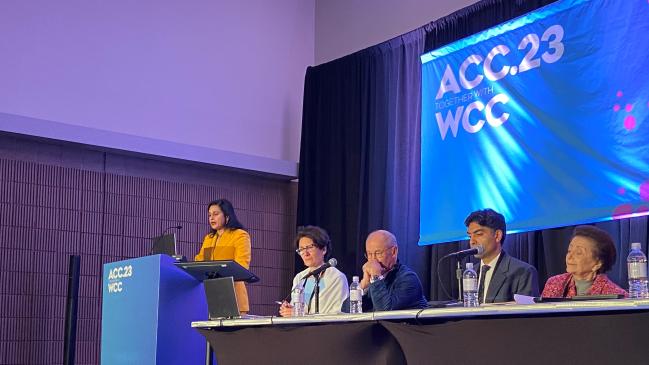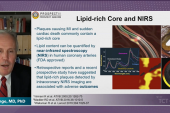Stable CAD Plaque Morphology Improved by PCSK9 Inhibitors: YELLOW III
Intensified LDL-lowering upped fibrous cap thickness on OCT and cut lipid burden on NIRS. Next up: biomarkers to predict effects.

NEW ORLEANS, LA—Twenty-six weeks of PCSK9 inhibitor therapy on top of maximally tolerated statins increases markers of plaque stability in patients with stable coronary artery disease and may, down the line, yield clues as to how to identify those who would benefit most from intensification of their lipid-lowering drugs and which agents may be best suited to the job.
Add-on evolocumab (Repatha; Amgen) produced a “significant and substantial” increase in plaque minimum fibrous cap thickness (FCT) on optical coherence tomography (OCT) and a reduction in lipid core burden index (LCBI), on near-infrared spectroscopy (NIRS) in angiographically nonobstructive lesions, said lead investigator Annapoorna S. Kini, MD (Mount Sinai Hospital, New York, NY).
Kini reported the YELLOW III findings here during a featured clinical research session of the American College of Cardiology/World Congress of Cardiology (ACC/WCC) 2023 meeting.
Prior studies have established the ability of PCSK9 inhibition to reduce residual CV risk in statin-treated patients, Kini noted. Both the 2019 European dyslipidemia guidelines and the 2018 ACC/American Heart Association cholesterol guidelines recommend the use of PCSK9 inhibitors in patients with stable CAD if sufficient LDL-lowering is not achieved on maximally tolerated doses of statins and ezetimibe. GLAGOV demonstrated reductions in percent atheroma volume on IVUS in stable CAD patients, while HUYGENS showed thickening of fibrous plaques on OCT and PACMAN-AMI documented a drop in maximum LCBI (maxLCBI4mm) by NIRS, both in acute MI patients.
Kini et al’s prior YELLOW II study, also in stable coronary disease, used the same range of imaging modalities to show that high-intensity statin therapy helps to shore up vulnerable plaque morphology.
For the current study, YELLOW III investigators turned to evolocumab in patients already maxed out on statins, looking both for signs of plaque stabilization and for genetic markers of medication activity in peripheral blood mononuclear cells (PBMC).
The study screened more than 300 patients undergoing PCI also found to have an additional nonculprit, nonobstructive lesion (30-50% stenosis). After OCT and NIRS/IVUS imaging of the secondary lesion performed after culprit-vessel PCI, 137 patients were identified as having lipid-rich plaques despite moderate- or high-intensity statin; 110 patients ultimately completed the 26 weeks of PCSK9 inhibitor therapy.
Total cholesterol, LDL cholesterol, and total/HDL cholesterol ratios all fell during the 26 weeks of evolocumab therapy, while the drop in triglycerides was not statistically significant and gains in HDL were nominal.
In keeping with those LDL reductions, however, both OCT and NIRS parameters—the study’s primary endpoints—changed significantly from baseline to 26 weeks. On OCT, FCT increased from 70.9 µm to 97.7 µm and maxLCBI4mm NIRS fell from 306.8 to 213.1 (both P < 0.001).
Those primary results were corroborated by a range of secondary imaging endpoints on OCT and IVUS, including a drop in total atheroma volume. In all, Kini noted, the prevalence of high-risk vulnerable thin- cap fibroatheroma fell from 48% to 13%; fibrous cap thickness increased in 80% of patients.
“This is the first multimodality imaging report in stable patients with nonobstructive lesions and lower levels of LDL-C at baseline, as compared to previous trials, and further supports aggressive lipid-lowering in the patient population,” Kini concluded.
Biomarker Hopes
A key aim of the YELLOW III trials is the genotypic characterization of patient response to statins and PCSK9 inhibitors—both drugs are associated with improvements in plaque pacification, to differing degrees, but they not only work differently in different patients: some patients do not derive benefit at all. The hope is that the genetic component of the YELLOW trial series, using deep-learning models derived from differentially expressed genes in PBMC, would lead to the identification of biomarker tests that can predict who might benefit the most from different approaches to lipid-lowering.
Such studies, Kini said, might also help to answer questions of whether “lower is better” or whether it matters how you get there.
“PBMC transcriptomic data will allow us to create predictive models for detecting subjects who demonstrate the greatest response regarding plaque morphology to PCSK9 inhibition therapy,” Kini concluded.
That’s important, Kini stressed to TCTMD, because PCSK9 inhibitors are expensive in a healthcare system already groaning under the financial burden of care. Moreover, as their analysis revealed, fully 20% of patients showed no FCT thickening and nearly one in four had no signs of LCBI reduction.
Clinical Takeaways
Kini acknowledged that most cardiologists have no experience with the advanced intravascular imaging used in YELLOW III, nor much use for transcriptional genomics in everyday practice. For now, she stressed that the takeaways should be that intensifying LDL-lowering matters and has measurable effects on coronary plaques that will likely reduce secondary events. Another key message is that the knowledge gleaned in studies like this one will help physicians personalize therapies for their patients.
But that doesn’t mean that everyone should be on PCSK9 inhibitors, stressed Kini. “That has to be very clear—I don't want [to send] a wrong message, saying everybody should be on this expensive medication, no. The financial burden to healthcare is a lot: statins already are a big, billion-dollar industry,” and the PCSK9 inhibitors are substantially more expensive.
The first step, she urged, should be lifestyle modification—exercise and diet—followed by statin initiation and intensification. Statin-treated people with multiple risk factors would be the ones in whom a biomarker might ultimately be helpful in deciding whether a PCSK9 inhibitor, or some of the other emerging medications, might help get their LDL down and their plaques more stable.
Commenting on the YELLOW III after the presentation, Ik-Kyung Jang, MD, PhD (Massachusetts General Hospital, Boston, MA), said that, in his view, “the main message of your study is: the lower the better, even in stable angina patients.” While earlier studies have established that plaque disruption followed by plaque healing plays a key part in ACS, the current study supports the role for aggressive lipid-lowering as a means of attenuating atherosclerosis progression.
“What’s most interesting to me is the genetic study,” Jang continued. “Identifying not only the responders but especially the nonresponders: this should be the target population for future research. We don’t know if [a lack of plaque morphology changes in] these nonresponders will extrapolate to clinical outcomes, and we don’t know how to treat these people. [But] consistent with previous studies, especially PACMAN-AMI, if you put these trials together I think it teaches us that plaque responds to aggressive lipid-lowering drugs.”
Shelley Wood was the Editor-in-Chief of TCTMD and the Editorial Director at the Cardiovascular Research Foundation (CRF) from October 2015…
Read Full BioSources
Kini AS. Effect of evolocumab on coronary plaque characteristics in stable coronary artery disease: a multimodality imaging study (the YELLOW III study). Presented at: ACC/WCC 2023. March 4, 2023. New Orleans, LA.
Disclosures
- YELLOW III was supported by Amgen and Abbott Vascular.
- Kini had no relevant conflicts of interest.





Comments